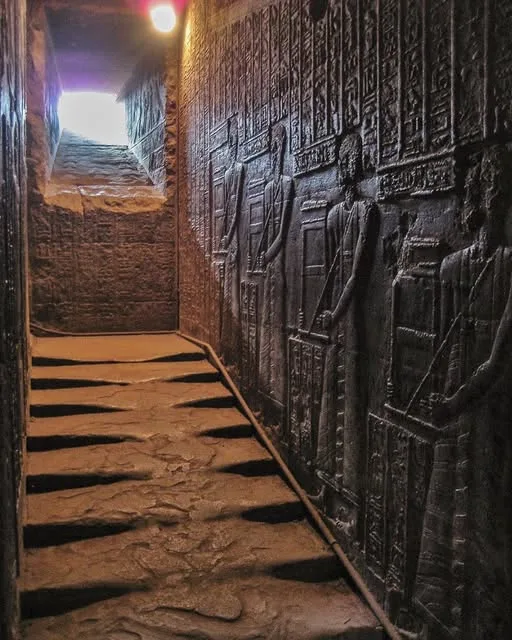The air inside the ancient Egyptian temple hung thick and still, carrying the faint scent of millennia-old stone. Sunlight, a stark contrast to the eternal dimness within, spilled from an opening high above, illuminating a path of stone steps that seemed to defy the very laws of solid matter. This was no ordinary staircase; these were the steps leading to the sacred roof of the Temple of Hathor at Dendera, a structure that has stood for over 2,300 years, a monument to a goddess and the mysteries of the past.

The scene is mesmerizing. On the right, the wall is a canvas of deeply carved hieroglyphs and divine figures, their forms crisp and detailed, seemingly untouched by the passage of time. Yet, directly beneath them, the very steps carved from the same ancient rock tell a different story. They don’t just show wear; they appear to have flowed, their once sharp edges softened into undulating waves, their surfaces dipping and rising as if molded by an unseen force. This “melted” appearance is what instantly captures the eye and ignites curiosity.
For centuries, this visual anomaly has puzzled visitors and scholars alike. How could stone, particularly the durable sandstone used in ancient Egyptian construction, achieve such a plastic-like deformation? The common assumption, of course, was foot traffic. Millions upon millions of bare feet, leather sandals, and perhaps even the occasional ceremonial shoe, trudging up and down over two millennia. But could mere friction create such a dramatic, almost sculptural effect?
Other theories emerged, attempts to rationalize the unexplainable. Some pointed to the Nile River, just a mile away, suggesting water erosion. Perhaps ancient floods or persistent dampness had slowly dissolved and shaped the stone? Yet, this theory quickly faltered; the impeccably preserved carvings on the adjacent walls showed almost no signs of similar water damage. If water was the culprit for the steps, why not the walls?
Then came the more sensational, even fantastical, ideas. In an age where ancient mysteries often collide with modern speculation, some whispered of “solar plasma events” or unknown energetic forces. While intriguing, these theories often lacked concrete evidence and felt, to many, “far-fetched.”
The riddle of the “melted” stairs lingered, a tantalizing secret held by the very fabric of the temple itself.
Driven by this enduring enigma, a query was posed to a friend, a geologist, whose understanding of rock, erosion, and the subtle dance of chemistry could offer a different perspective. And his theory, grounded in the silent, relentless processes of nature, provides the most compelling answer yet:
“So, these steps are made from a tough sandstone held together by calcite,” he explained, painting a picture of the rock’s fundamental composition. “When it’s fresh, it’s super durable and splits nicely into blocks—perfect for building, as the Egyptians knew so well.”
Then came the crucial “twist.” “But here’s the twist: while it handles wear and tear well, it’s vulnerable to chemical weathering. The calcite dissolves pretty easily in slightly acidic water—like rain with a bit of CO2, or even sweat.”
And here’s where the story of millions of pilgrims, priests, and modern tourists truly converges with geology: “And since we exhale moist, CO2-rich air, every visitor is basically helping break it down a little. Each footstep might only loosen a few grains, but over time and millions of people, that adds up.”
The genius of his explanation lay in the final piece of the puzzle: “Then, thanks to daily changes in temperature and humidity, some of that dissolved calcite gets redeposited lower down, sort of ‘gluing’ the grains back in place—just a bit off from where they started. The result? A slow buildup that looks like the stone has flowed, even though it hasn’t. It’s not melted—just reshaped, grain by grain, foot by foot, over centuries.”
The “melted” stairs of Dendera are not a testament to a forgotten ancient technology, or an improbable cosmic event. Instead, they are a powerful, tangible record of time itself, shaped by the most subtle and relentless forces: the very breath and sweat of generations of humanity, interacting with the fundamental chemistry of the Earth. It’s a reminder that sometimes, the most astonishing mysteries have the most elegant and scientific explanations, silently unfolding over thousands of years, grain by painstaking grain.





